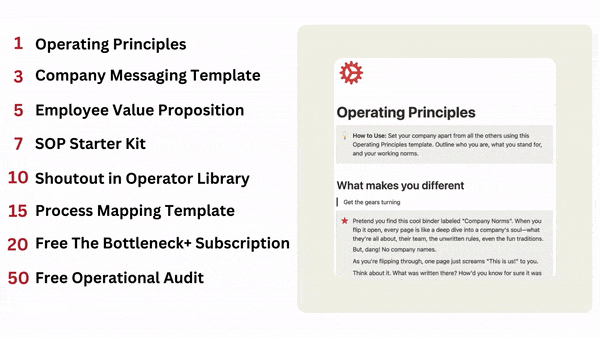
Read Time: 3.8 Minutes
Happy Sunday Operators ⚙️
Are you tired of figuring out how to run your startup day-to-day by yourself?
Let me guess what your day looks like.
You start out by waking up, rolling over to check your phone, and seeing 100+ emails. A bit of adrenaline wells up in your body.
You scroll through the list of messages you need to respond to.
You need to help with CX tickets, handle the latest state compliance issue, get back to your accountant about your books being done wrong, and 30 other processes on fire.
After putting out all these fires, you didn’t get time to strategize on what needs to be done to scale the business.
Your day-to-day shouldn’t be like this.
You should be spending your time on the big things. Not on minor tasks.
By upgrading your subscription to The Bottleneck+, you will get access to:
A group of company operators who face the same problems as you
Templates to help you scale your business
Lessons from the best 50+ business leaders in the world
Tool and vendor recommendations on what works best for your business
Software tools that can help you 10x your business
Time is ticking to upgrade your subscription.
I plan to raise rates from $70 to $170 dollars a year on Feb 1st.
To lock in your rate now, click the upgrade button below. Once there, select a monthly or yearly subscription. Enter your credit card details, and voila! You’re now part of the club.
While you hit that upgrade button, we’re diving into Amazon today.
How did Amazon build a world-class customer experience with 5 people?

What was Amazon in 1996
In the mid-90s, Amazon.com was more of an ambitious experiment than the e-commerce juggernaut we know today. Nestled in downtown Seattle, it was a playground for generalists.
Enter Jane Slade and Colleen Byrum in 1996.
Slade and Byrum steered the ship of Amazon's nascent customer service.
When both joined, the support team had to navigate a digital landscape with just a memorized list of commands on their X-terminals with only 5 members.
Picture disaffected PhDs and Master's students, lured by stock options they barely understood, for a modest $10 an hour.
Their job?
Navigating Unix at a command line prompt, with the constant risk of accidentally crashing the website.
In the same year Slade and Byrum joined, Amazon hit a milestone. A Wall Street Journal profile on Jeff Bezos catapulted the company into national consciousness.
Suddenly, Amazon's clientele wasn't just tech-savvy early adopters. Now, they were fielding calls from the general public.
The support team not only had to explain what Amazon was but also basic internet functionalities like scrolling or clarifying that Amazon and Hotmail were, indeed, different entities.
Brad Stone's 'The Everything Store' depicts this era. Revenue grew 30 to 40 percent monthly when planning was futile, and employees often struggled to recall this tumultuous, formative period.
It was a time of making things up on the go.
So, how did Slade and Byrum build a world renowned CX team?

Why should you care?
Customer experience drives everything
Fast forward to 2024, Amazon is known for its hyper-focus on customer experience.
Jeff Bezos has continually emphasized that everything else falls into place if you focus on the customer.
Bezos realized early on that customer experience can impact your business. Based on customer surveys:
97% of consumers say customer service interactions impact whether they stay loyal to a brand.
61% of consumers will pay at least 5% more if they know they’ll get a good customer experience.
88% of buyers say experience matters as much as a company's products or services
As a leader of your own business, you want your employees and peers to care just as much as you do.
To be the best, this is what Amazon focuses on to provide an amazing customer experience:
1. Ever-Evolving Customer Expectations: Amazon recognizes customer satisfaction is a moving target. Jeff Bezos emphasized this in his 2017 Letter to Shareholders, noting that customers are "divinely discontent." Their expectations are always increasing, making yesterday's innovations today's standards.
2. Speed and Proactivity in Innovation: Instead of reacting to customer feedback, Amazon focuses on anticipating changes and developing solutions.
3. Centering on Durable Needs: By understanding what customers will always value over time (like price, selection, and convenience), Amazon can innovate in ways that add value. This approach is evident in how they developed their Prime service, adding benefits and refining the core offering to align with evolving customer needs.
4. Customer-Centric Culture and Innovation: Amazon's ethos is centered around customer obsession. Their leadership principle of 'Customer Obsession' and working backward from customer needs to ensure every innovation and decision has the customer always in mind.
5. Data-Driven Decision-Making and Voice of the Customer: Amazon collects data, analyzes customer feedback, and predicts trends to build their product roadmap. By building a strong 'Voice of the Customer' framework, they can make faster, more informed decisions prioritizing customer experience.

How do you do this?
Colleen Byrum realized the impending surge of growth following the Wall Street Journal profile.
Her immediate response? Building a robust pipeline of candidates to handle the influx.
Byrum's strategy was straightforward yet bold.
She contacted every temp staffing agency in Seattle, announcing the need for 500 candidates in the coming months.
The catch?
Agencies had to meet her stringent standards or risk losing the contract.
This was her unique approach to "hoovering up great clumps of people."
Jane Slade emphasized the critical need for articulate communicators. With customer service conducted via email, effective writing and handling technology was paramount.
Despite the aggressive recruitment strategy, Amazon's growth outpaced its management ability.
The growth of Amazon swamped the customer service team.
The solution?
The 'disaffected Ph.D. Skunkworks.'
Byrum's approach was unconventional: tapping into the University of Washington's pool of disenchanted graduate students. The best fit was Ph.D. and graduate students who were burnt out on trying to get their degrees.
Byrum knew that these students would be high-effort workers who could communicate well and had the desire to learn. A huge difference from the temps she had been hiring.
With a team in place, automation became a focus.
At first, the team looked into outside vendors but found a surprise. None could handle Amazon's volume.
The decision to build customer service tools in-house was partly out of necessity.
Among her recruits was Clark Grubb, a night manager at a hotel, who, along with others, learned Perl and SQL to automate customer service processes.
This strategy paid off. The team split between customer service duties and coding. They began developing tools that 100x improved efficiency.
The result was an effective way to manage customer emails and orders.
By combining a unique sourcing hack with building automations in house, the team at Amazon was able put on the rails for the CX behemoth it is today.

Spread The Word
Share The Bottleneck with friends to get a few freebies. Maybe you’ll make some new friends along the way 😆
We’ll give you free stuff and more friends if you share a link. Only one link.

{{rp_personalized_text}}

